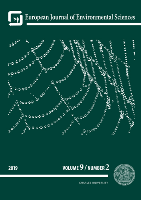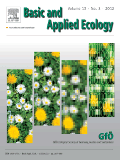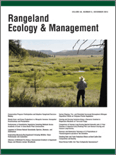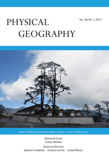
LANDSCAPE ECOLOGY
Scope & Guideline
Illuminating Environmental Challenges with Cutting-Edge Studies
Introduction
Aims and Scopes
- Landscape Structure and Function:
Research on how different landscape configurations affect ecological processes, species distributions, and ecosystem functions. This includes studying habitat connectivity, fragmentation effects, and the role of landscape heterogeneity. - Biodiversity Conservation:
Investigations into the relationships between landscape patterns and biodiversity, including assessments of species richness, habitat suitability, and conservation strategies in various ecosystems. - Ecosystem Services:
Exploration of how landscape features influence the provision of ecosystem services, such as pollination, water purification, and carbon storage, highlighting the importance of landscapes in supporting human well-being. - Human-Environment Interactions:
Studies that examine the impacts of human activities on landscapes and ecosystems, including urbanization, agricultural practices, and policy implications for sustainable landscape management. - Climate Change Adaptation:
Research focused on understanding how landscapes can be managed to mitigate and adapt to the impacts of climate change, including habitat restoration and resilience building. - Methodological Innovations:
Development and application of new methods and tools for landscape analysis, including remote sensing, spatial modeling, and participatory approaches.
Trending and Emerging
- Cultural Ecosystem Services:
Recent publications are increasingly focusing on how landscapes contribute to cultural services, emphasizing the importance of human well-being and the socio-cultural dimensions of landscapes. - Urban Ecology and Green Infrastructure:
There is a growing trend towards studying urban landscapes, particularly the role of green infrastructure in mitigating urban heat islands and enhancing biodiversity within cities. - Climate Change and Resilience:
Research addressing the impacts of climate change on landscapes, including resilience strategies and the adaptive capacity of ecosystems, is gaining momentum. - Participatory Approaches in Landscape Management:
Emerging studies are incorporating participatory methods that engage local communities in landscape planning and management, highlighting the importance of stakeholder perspectives. - Machine Learning and Big Data Applications:
The integration of machine learning and big data analytics in landscape ecology research is on the rise, facilitating advanced modeling and predictive analyses of ecological patterns. - Multi-Scale and Multi-Taxa Analyses:
There is an increasing interest in multi-scale studies that assess ecological dynamics across different spatial and temporal scales, as well as multi-taxa approaches that consider various species interactions.
Declining or Waning
- Traditional Ecological Studies:
There appears to be a decrease in studies focused solely on traditional ecological dynamics without considering human impacts or landscape modifications. The field is increasingly integrating social science perspectives. - Static Models of Landscape Connectivity:
Research that relies on static models of connectivity without accounting for dynamic changes in landscapes or species behavior is becoming less prominent, as there is a growing emphasis on more flexible, adaptive modeling approaches. - Single-Species Focus:
The trend is shifting away from studies centered on single species towards more holistic approaches that consider multi-species interactions and community dynamics within landscapes. - Fragmentation Effects in Isolation:
There's a noticeable reduction in studies that examine fragmentation effects in isolation from other ecological factors, as researchers now prioritize integrated assessments that consider multiple drivers of change. - Local Case Studies:
While local case studies have been valuable, there is a decline in their prevalence as the journal increasingly encourages broader, comparative studies that can inform global conservation strategies.
Similar Journals

Journal of Mountain Science
Advancing Insights into Earth's Majestic Mountain EnvironmentsThe Journal of Mountain Science, published by SCIENCE PRESS, is a distinguished academic journal dedicated to advancing the understanding of mountain environments and their significance in various scientific domains. With an ISSN of 1672-6316 and an E-ISSN of 1993-0321, this journal has carved a niche in the field of Earth sciences, earning a commendable Q2 ranking in categories such as Earth-Surface Processes, Geography, Planning and Development, and Geology, as well as a Q3 ranking in Global and Planetary Change. Since its inception in 2007, the journal has been pivotal in fostering interdisciplinary research that addresses critical environmental issues, making it an essential resource for researchers, professionals, and students alike. While currently not offering open access, it provides valuable insights into areas including nature conservation and landscape management, with a focus on the unique challenges faced by mountainous regions. Located in Beijing, China, the Journal of Mountain Science continues to promote scholarly discourse that contributes to the sustainable development of mountain communities and ecosystems until 2024 and beyond.

GLOBAL ECOLOGY AND BIOGEOGRAPHY
Exploring the Interconnectedness of Life on EarthGLOBAL ECOLOGY AND BIOGEOGRAPHY is an esteemed academic journal published by Wiley that focuses on the dynamic interplay between ecological and biogeographical processes across the globe. With a strong commitment to advancing our understanding of biodiversity, conservation, and global change, this journal has secured a prestigious Q1 ranking in several categories, including Ecology, Ecology, Evolution, Behavior and Systematics, and Global and Planetary Change, highlighting its significant influence in the field. Since its inception in 1998, the journal has consistently provided a platform for high-quality research, featuring original articles that address critical ecological questions and emerging biogeographical trends. Researchers aiming to publish impactful work will appreciate the journal's rigorous peer-review process and its accessibility to a global audience. With a commendable track record reflected in its Scopus rankings, this journal is an essential resource for anyone dedicated to the study of ecology and biogeography.

WEB ECOLOGY
Unraveling the Complexities of Web EcologyWEB ECOLOGY is a premier academic journal published by COPERNICUS GESELLSCHAFT MBH, specializing in the field of Ecology, with a specific emphasis on the intricate interrelations between web-based ecosystems and environmental factors. Since its inception in 2000, this Open Access journal has provided an invaluable platform for researchers, professionals, and students to disseminate and access cutting-edge research findings. Currently based in Germany, WEB ECOLOGY has garnered a significant reputation, evidenced by its prestigious Q2 quartile ranking in both Ecology and Ecology, Evolution, Behavior and Systematics as of 2023. Furthermore, its impressive Scopus rankings, placing it within the top quartiles of its categories, highlight its relevance and influence in the field. With comprehensive coverage from 2000 to 2024, the journal aims to foster dialogue and innovation in ecological research, making significant contributions to our understanding of web ecology and inviting submissions that push the boundaries of current knowledge.

European Journal of Environmental Sciences
Empowering Research for a Sustainable FutureEuropean Journal of Environmental Sciences is a prominent open-access journal dedicated to disseminating high-quality research in the field of environmental science. Published by Charles University, Faculty of Mathematics & Physics, this journal has been a vital platform since 2011, facilitating free access to insightful studies and findings pertinent to pressing environmental issues. Its scope encompasses crucial topics in Ecology, Management, Monitoring, Policy, Law, Nature and Landscape Conservation, and Pollution. With a significant presence in the academic community, the journal currently holds a Q3 and Q4 category ranking in various subfields of environmental science, as assessed in 2023, showcasing its relevance and impact in the discipline. Researchers, professionals, and students engaging with the European Journal of Environmental Sciences will find it an essential resource for enhancing their understanding of environmental challenges and contributing to innovative solutions.

Ecological Indicators
Exploring vital indicators for a healthier planet.Ecological Indicators, published by Elsevier, is a prestigious journal dedicated to advancing the fields of ecology and environmental science. With an impressive impact factor and ranked in the Q1 quartile for both Ecology and Decision Sciences categories, the journal serves as a vital resource for researchers and professionals aiming to apply ecological knowledge to real-world problems. The journal covers a broad scope of topics within ecological indicators, aiming to provide comprehensive insights into biodiversity, ecosystem health, and sustainability metrics. Founded in 2001 and continuing through 2024, Ecological Indicators has established itself as a leader in disseminating significant research and innovative findings. The journal's standing is reflected in its remarkable Scopus ranks, placing it among the top percentile in its respective categories. Authors are encouraged to submit their work to share vital findings with an engaged audience of researchers, professionals, and dedicated students, ensuring the continued relevance and impact of ecological research on global environmental policies and practices.

BASIC AND APPLIED ECOLOGY
Bridging theory and practice in the realm of ecology.BASIC AND APPLIED ECOLOGY, published by Elsevier GmbH in Germany, stands out as a premier journal in the field of ecology, evolution, behavior, and systematics. With its ISSN 1439-1791 and E-ISSN 1618-0089, the journal enjoys a distinguished reputation, evidenced by its classification in the Q1 category for Ecology in 2023 and impressively ranking #89 out of 721 in this domain according to Scopus. Since its inception in 2000, it has served as a vital platform for disseminating high-quality research that bridges theoretical insights and practical applications in ecology. Researchers, professionals, and students alike can look forward to the latest findings that not only foster a deeper understanding of ecological processes but also inform sustainable practices crucial for our environment. As the journal continues its journey through to 2024, it remains committed to advancing ecological knowledge and supporting innovative research in an ever-evolving field.

ECOLOGY LETTERS
Bridging theory and practice in the world of ecology.ECOLOGY LETTERS, published by Wiley, is a premier journal dedicated to advancing the field of ecology and related disciplines. Renowned for its rigorous peer-review process and impactful research contributions, the journal boasts an impressive Scopus Rank of #13 out of 721 in the category of Agricultural and Biological Sciences, positioning it in the 98th percentile globally. With a Q1 rating in the 2023 quartile rankings for Ecology, Evolution, Behavior and Systematics, it serves as an essential platform for ecologists and evolutionary biologists to disseminate cutting-edge research findings from 1998 to 2024. Although not an open-access journal, ECOLOGY LETTERS actively contributes to the global ecology discourse, making it a critical resource for researchers, professionals, and students dedicated to understanding complex ecological interactions and evolutionary processes.

Rangeland Ecology & Management
Elevating Research on Rangeland Ecosystem DynamicsRangeland Ecology & Management, published by ELSEVIER, is a leading academic journal dedicated to the interdisciplinary exploration of varied aspects of rangeland ecosystems, including their sustainable management and conservation. With an ISSN of 1550-7424 and an E-ISSN of 1551-5028, the journal has established itself as a vital resource in the fields of Animal Science and Zoology, Ecology, and Management, Monitoring, Policy and Law, achieving prominent Q1 quartile rankings in these categories as of 2023. The journal's significant Scopus rankings further attest to its impact, securing a position in the top percentiles of related fields. Published of noteworthy research from 2005 to 2024, Rangeland Ecology & Management serves not only as an academic platform but also fosters meaningful discussions on rangeland policy implications across the globe. The journal offers both subscription and Open Access options, ensuring that innovative research is readily available to researchers, professionals, and students passionate about ecology and sustainable practices. Join the Rangeland Ecology & Management community and contribute to advancing our understanding of rangeland ecosystems.

RUSSIAN JOURNAL OF ECOLOGY
Illuminating the Path to Sustainable Ecological SolutionsRUSSIAN JOURNAL OF ECOLOGY, published by PLEIADES PUBLISHING INC, stands as a critical resource within the field of ecology, offering an array of research insights that span various ecological topics. With an ISSN of 1067-4136 and an E-ISSN of 1608-3334, this journal has been consistently disseminating knowledge since its inception in 1996, now converging towards 2024. Despite its current Q4 ranking in the Ecology, Evolution, Behavior and Systematics category, the journal has carved out a niche in the publication landscape, particularly for scholars focused on the rich and diverse ecological phenomena of Russia and surrounding territories. The journal aims to foster interdisciplinary collaboration and innovation by providing a platform for the dissemination of high-quality research. While it currently lacks open access options, readers can expect in-depth studies and analytical discourses that contribute meaningfully to the global understanding of ecological systems. With an impressive Scopus rank, this journal remains an important outlet for researchers, professionals, and students committed to advancing ecological science.

PHYSICAL GEOGRAPHY
Unveiling the Science of Our PlanetPHYSICAL GEOGRAPHY is a prominent academic journal published by Taylor & Francis Ltd, focusing on a wide array of topics within the realm of physical geography, including atmospheric science, earth sciences, and environmental science. With an esteemed history since its inception in 1975 and covering research up to 2024, this journal holds significant relevance in academia, evidenced by its ranking in the Q2 category for both Earth and Planetary Sciences and Environmental Science, as well as its Q3 standing in Atmospheric Science for 2023. This journal serves as a vital platform for scholars and practitioners alike, fostering the dissemination of innovative research findings and interdisciplinary collaboration. Although it is not an Open Access journal, it remains highly regarded, with Scopus rankings placing it within the top percentile of its categories. Researchers, professionals, and students seeking to contribute to or keep abreast of critical developments in the field will find PHYSICAL GEOGRAPHY an indispensable resource for advancing their knowledge and understanding of physical geographic phenomena.